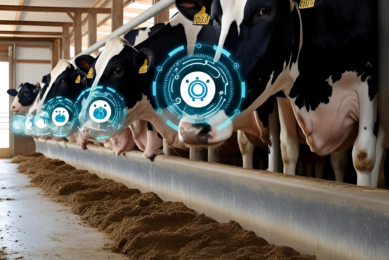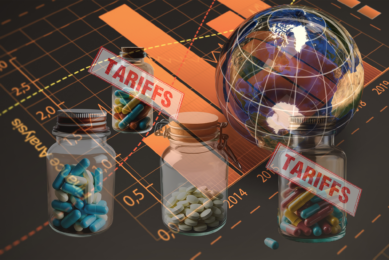Vitamin E – what it is good for

Apart from being an efficacious membrane antioxidant, vitamin E has a broad physiological importance, such as maintaining ?tissue’s structural integrity, supporting neural growth, ?reproduction and modulating immunity.
By G. Litta, T. K. Chung and G.M. Weber , DSM Nutritional Products,
Animal Nutrition and Health
Vitamin E, known as all – rac -α-tocopheryl acetate in commercial form as animal feed supplementation, is present in natural form in the lipid fraction of feed ingredients, albeit susceptible to oxidation. Vitamin E cannot be synthesised by poultry and pigs and thus must be included in the diet.
The function and metabolism
The unique function of vitamin E cannot be fulfilled by other dietary substances. Vitamin E is well recognised as the most effective lipid-soluble, chain-breaking antioxidant, protecting cellular membranes from being attacked by lipid peroxyl radicals ( Figure 1 ). It prevents the propagation of lipid peroxyl radicals in cellular membranes. Lipid peroxyl radicals react 1000 times faster with vitamin E than with polyunsaturated fatty acids.
It helps to maintain the structural integrity of tissues, to develop the nervous system, and substantially contributes to disease resistance of animals due to its modulating effects on the immune system. Vitamin E is actively absorbed in the gut. Vitamin E is packaged into lipid-bile micelles and is transported via the lymphatic pathway to the liver, then with a specific transport-protein into the blood circulation.
Vitamin E deficiency symptoms
Vitamin E deficiency causes disorders of the cellular membrane, due to the oxidative degradation of polyunsaturated fatty acids. The symptoms are specific to each animal species. Vitamin E deficiency generally causes liver necrosis and is the reason for species-specific disorders such as exudative diathesis (abnormal permeability of the capillary walls) and encephalomalacia (‘crazy chick syndrome’) in poultry, Mulberry heart disease, which results in sudden heart failure of pigs and muscular dystrophy (‘white muscle disease’), particularly in ruminants. Sub-clinical vitamin E deficiency is hardly detectable but results in retarded growth and impaired feed conversion as well as lower fertility, higher susceptibility to infectious diseases and reduced stress resistance.
Supra-nutritional supplementation
Vitamin E requirements may increase under heat stress. In layers, several studies have concluded that a vitamin E supplementation between 125 and 500 mg/kg was necessary to alleviate the adverse effects of chronic heat stress on egg production, egg weight, egg shell density and feed efficiency. For broilers, supplementing starter feeds with 200 mg vitamin E per kg was found to minimise peroxidation of erythrocytes in various tissues at three and five weeks of age.
Immune response
In the immune system, vitamin E
prevents lipid peroxidation in membranes by stabilising arachidonic acid contents. Arachidonic acid is converted by cyclooxygenase and lipooxygenase to produce eicosanoids which are potent inducers of inflammation. Moreover, the biosynthesis of the pro-inflammatory eicosanoids increases during vitamin E deficiency.
Poultry
It was observed that 300 mg/kg vitamin E reduced mortality in E. coli infected poultry. Similar effects were obtained in turkeys, with dosages between 100 and 300 mg/kg, in cases of colibacillosis, coccidiosis, and listeriosis. Vitamin E also improved the immune response to vaccinations against Newcastle Disease and bronchitis. Vitamin E promotes the phagocytic activity of macrophages. Chicks from hens supplemented with 300 mg/kg vitamin E presented better humoral immunity and more active lymphocytes. Broilers infected with the virus causing malabsorption syndrome suffered less damage and recovered sooner when they received a higher vitamin E dosage.
Swine
Dietary levels of vitamin E above 60 mg/kg are necessary for optimum sow immune responses. Piglets are born with low levels of α-tocopherol. Although colostrum is rich in α-tocopherol during the first few days, it is still required during the final stages of gestation and lactation period. The content in the sow’s plasma and in the milk rises linearly when the feed concentration of vitamin E is increased from 70 to 250 mg/kg. At weaning the α-tocopherol level in the liver of piglets of which the mothers received 250 mg/kg is more than double than that of piglets from dams receiving 70 mg/kg. Similarly a significant variation in E. coli antibodies was measured in piglets born from sows receiving 70, 150 or 250 mg/kg feed of vitamin E: the higher the dosage the lower was the need to treat piglets against diarrhoea. At weaning, the pig’s limited digestive capacity reduces vitamin E tissue stores, susceptible to suffering oxidation processes. Adding vitamin E at 100-200 mg/kg increased the serum concentration of α-tocopherol.
Vitamin E and reproduction
Poultry
The quantity of vitamin E in the egg increases linearly with the intake of α-tocopherol by the hen. Supplementation of vitamin E above the minimum requirement improves ovulation during the last phase of the laying period. Vitamin E protects against oxidation in sperm, egg yolk and embryonic tract. Also, a direct relationship between the level of vitamin E in the liver of a day-old chick and its viability is demonstrated. It is especially critical in turkeys since vitamin E absorption is low, so that not only the level in the egg but also the transfer to the embryo and the reserve in newly hatched turkeys is lower than in chickens. The fertilising capacity of spermatozoa from breeder males is also related to vitamin E. When breeders are deficient in vitamin E, the males are less fertile due to the lower quantity and quality of sperm produced.
Swine
Researches demonstrated that younger sows experienced higher incidences of reproductive problems associated with inadequate vitamin E than older sows. However, use of vitamin E in the breeder sow is indicated to go much beyond improving number of piglets born or survival. In cattle there is a relationship between vitamin E intake and retained placentas or the number of somatic cells in milk.
With sows, a longer parturition duration was shown when the vitamin E intake is lower, due possibly to inadequate contraction of the smooth musculature. A relationship between vitamin E intake and the incidence of mastitis, metritis and agalactia has also been shown.
Vitamin E enrichment in eggs
When vitamin E up to 400 mg/kg was fed to laying hens, α-tocopherol in yolk increased from a control level of 144 mcg/g to 477 mcg/g. When feeding very high doses of vitamin E (100, 1,000, 10,000 and 20,000 mg/kg) during 20 weeks, vitamin E content of eggs increased from 1 to 4, 21, 46 and 51 mg per egg.
Meat quality
The beneficial effects of α-tocopherol acetate in feed on the oxidative stability and sensory quality of meat have been extensively researched. Oxidation processes are responsible for unpleasant smells and flavours, for changes in the nutritive value (reduction in the polyunsaturated fatty acid and fat-soluble vitamin content) and colour, and even for potential human health hazards such as cholesterol oxides.Oxidative stability in poultry meat is lower than for beef or pork due to its higher polyunsaturated fatty acid content. Supplementation of vitamin E is important if the fat incorporated in the feed is altered by oxidation or heat. The risk of oxidation is also increased by meat processing (e.g. freezing, mincing, seasoning, pre-cooking or meat irradiation). Feed supplementation is more effective in maintaining oxidative stability than adding it to meat since it will not be physiologically and naturally incorporated in cellular membranes.
Organoleptic characteristics
Poultry
E supplementation induced a lower drop in postmortem pH, which indicates a prevention of pale, soft and exudative meat syndrome (PSE) a problem which is more prevalent in turkeys than in broilers. Studies have shown, when the diets were fortified, drip losses were diminished, meat taste, flavour and texture were improved, which effects were more evident with storage times of 7–12 days.
Swine and cattle
The colour of pork meat is important, determined by the myoglobin pigment. When the meat is oxidised during storage, metmyoglobin is formed, which gives the meat an undesirable dark colouration. Supplementation of vitamin E improves the stability of meat colour, and data with beef cattle and lambs are more conclusive than with pigs. By increasing vitamin E content in feed, it is also possible to reduce the amount of certain additives included during processing as the meat contains a good quantity of antioxidants at the time of slaughter, bringing benefit to public health and the positive commercial implications associated with it.
Article featured in AllAboutFeed issue 21.4 2013











